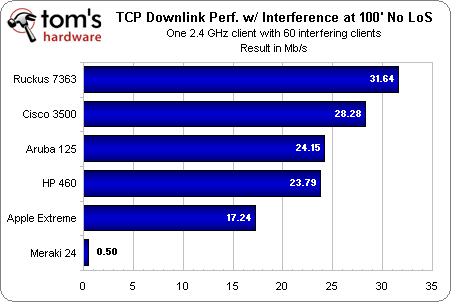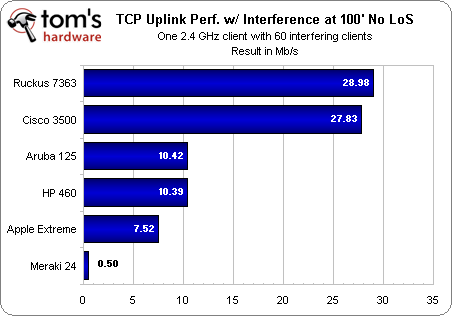Why Your Wi-Fi Sucks And How It Can Be Helped, Part 2
In Part 1, we explained what can go wrong with Wi-Fi signals and how access points can work to improve your wireless performance. It's time for a reality check. We throw six contenders against 65 clients and some hellish interference. Who's left standing?
Long-Range, 1 Versus 60 Clients Plus Noise
With interference from our 60 Wi-Fi clients (and connected access point), we again see a predictable and severe hit to performance across the board. Again, Apple impresses by plugging along, while poor Meraki stumbles again into the ditch, unable to complete the test. And again, Cisco shows its design prowess by seizing an almost 19% advantage over HP. To us, this exemplifies that deep design quality far outstrips marketing bullet points, such as three-stream support. If HP and Meraki are the best performance to be had from “450 Mb/s” access points, we’ll stick with hardier two-stream options any day.
Once more, we see the same story drawn even more dramatically in the uplink testing. Ruckus barely manages to hold Cisco at bay. Both leaders pull far ahead from the others, with Aruba and HP in a near dead heat for a distant third place.
Note that at these levels, none of our five competing APs would likely sustain a decent HD video signal. Unfortunately, what we measured was average sustained throughput over the course of a two-minute test run. There simply wasn’t enough time within our test window to also run minimum sustained throughput levels. After having seen Ruckus excel in this before, we really wanted to see if competing enterprise-class products could meet or beat Ruckus on this basis in our environment, particularly since streaming video looks to be playing an increasingly important role in K-12 education. Schools need to understand the technical limits of how and where their wireless networks can be deployed, especially when potentially many dozens of clients are involved. Even in a home environment, 100 feet for a video stream isn’t uncommon, although the amount of interference likely to be encountered by consumers should be less than we inflicted here.
Get Tom's Hardware's best news and in-depth reviews, straight to your inbox.
Current page: Long-Range, 1 Versus 60 Clients Plus Noise
Prev Page Long-Range, No Interference Next Page 60 Laptops: Aggregate Performance-
winner4455 Hey, I still haven't read this article but right away I notice the new format. Just thanking you for listening to your readers! :)Reply -
cangelini Very welcome Winner. We thought the picture story format would work for that last part and didn't realize the text would come out to be so terrible. From now on, we'll only use picture stories when the captions fit without requiring another click!Reply -
tacoslave cangeliniVery welcome Winner. We thought the picture story format would work for that last part and didn't realize the text would come out to be so terrible. From now on, we'll only use picture stories when the captions fit without requiring another click!"Now thats what i like to hear!"Reply -
nekromobo What if you add few thin-foil balls to room (the size of fist or 2)Reply
That should add few rf-reflections or paths, right?
Just your 2cent amplifier.. :) -
I wonder why you didn't include Juniper products (formerly trapeze)to this test. It's quit a big player here in europe. Trapeze also produced the 3com wireless manager and accesspoints which was sold widely here.Reply
-
Hupiscratch In the page "Benchmark Results: Close Range, No Interference", the HP AP is missing on the downlink graph.Reply -
Onus This was an outstanding article. Going just by this, Ruckus and Cisco are the only two I'd consider out of the box, but it would be very interesting to do a follow on that features even a minimal amount of tweaking to see what changes. A consumer expects a product to work well out of the box, but an enterprise network engineer almost certainly does not.Reply
-
Very thorough. Lots of hard work went into this and it shows. But how did you select client devices? Did you try any other chipsets? We tried something like this with more diverse clients and got results that were too variable to reach conclusions. (Some clients just did better with some APs than others.)Reply

